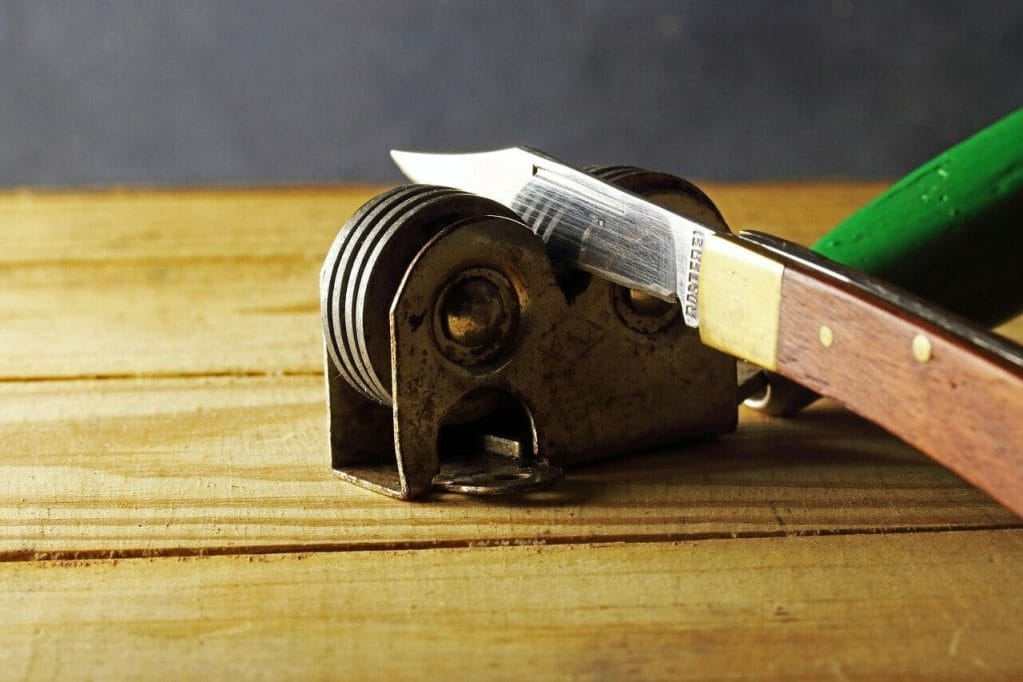Knife sharpeners are essential for any kitchen. Dull blades can cause delay and increase the risk of accidents. So, get a good sharpener!
Electric sharpeners offer quick results. They reshape and hone the blade’s edge with rotating abrasive materials.
Manual sharpening stones are also popular. They require skill but offer precise control. Slide the blade across the coarse side at a specific angle, followed by finer grits.
For convenience and portability, try handheld pull-through sharpeners. Draw the knife through each slot several times for sharpness.
At some point, professional sharpening is necessary to regain optimal performance. Professional sharpeners use advanced techniques for even results.
Invest in a high-quality sharpener and enjoy effortless slicing and dicing! Keep your knives sharp for great culinary experiences and reduce the risk of accidents.
Knife Sharpening Methods
Choose the right knife sharpening method for you! From traditional stones to electric sharpeners, there are several options to help blades stay sharp. Stones are the oldest and require skilled technique. Honing rods realign the edge without removing metal. Pull-through sharpeners offer simplicity and convenience. Electric sharpeners are automated and expensive. Sharpening systems have guided angles. Diamond sharpeners remove aggressive material. Also look into ceramic rods, sandpaper, and services. Have precision cutting, avoid accidents, and experience effortless slicing – invest in a reliable sharpener!
Pros and Cons of Each Type
When it comes to sharpening knives, each type has its own advantages and disadvantages. To understand better, let’s take a closer look at the different types and their individual features.
Let’s start by creating a table to compare the pros and cons of each type:
| Type | Pros | Cons |
|---|---|---|
| Manual | Allows precision | Requires effort and time |
| Electric | Quick and easy | Can be expensive |
| Sharpening systems | Consistent results | Requires skill and practice |
| Stones | Versatile for different blades | Takes longer for sharpness |
Now that we have a visual overview of the pros and cons, let’s explore some unique details about each one.
Manual sharpeners are great if you want precise results as they give you more control over the process. However, they do take more effort and time than other types.
Electric sharpeners are convenient and fast, making them a popular choice. The downside is they may be pricier than manual options.
Sharpening systems provide consistent results by guiding the blade at the right angle. They are reliable but require some skill and practice to master.
Lastly, stones are known for their versatility as they can be used on various blades. However, it takes longer to achieve sharpness with this method.
Interestingly, knife sharpeners have existed for centuries. The first evidence of knife sharpening was found in ancient Egypt using copper tools. Over time, different techniques were developed, leading us to the wide range of knife sharpeners available today.
Find the best and most affordable knife sharpeners by clicking here!
Factors to Consider When Choosing a Knife Sharpener
When picking a knife sharpener, there are key aspects to keep in mind. A reference table can provide an overview of these factors. It highlights the sharpening method, angle, design, material, and safety features.
Honing vs grinding must be understood when choosing a sharpening method. Low angles (15-20 degrees) are better for delicate tasks, while higher angles (20-25 degrees) are ideal for tough jobs.
Knife sharpeners have been used for thousands of years. Modern-day sharpeners offer efficiency and convenience.
Remember, the right sharpener is vital for keeping blades in good condition. Consider these factors, research, and make an informed choice to improve your culinary experience.
Conclusion: Finding the Right Knife Sharpener for Your Needs
Searching for the ideal knife sharpener can be overwhelming. But, if you know the right info, you can make the perfect pick. Here are three points to think about:
- Type of knives you have: Sharpeners are made for different knives. If you have serrated blades, you need a sharpener designed for that.
- Convenience and ease of use: Some sharpeners need more effort than others. Think of your patience and skills when picking one.
- Your budget: Knife sharpeners come in various prices, so it’s good to know what you can afford. Investing in a quality sharpener saves you money in the long run.
Plus, electric sharpeners offer speed, great for rush kitchens. Remember to read the manufacturer’s instructions before using any sharpener to get the best results and avoid harming your knives.
Also, read our popular blog articles:
Maintaining Your Knife Sharpness: Tips for Long-lasting Performance
Manual vs Electric Knife Sharpener
Frequently Asked Questions
Q: What are the different types of knife sharpeners?
A: There are several types of knife sharpeners available in the market, including manual sharpeners, electric sharpeners, honing rods, sharpening stones, pull-through sharpeners, and sharpening systems.
Q: How does a manual knife sharpener work?
A: A manual knife sharpener typically consists of two sharpening slots with abrasive materials. By pulling the knife through these slots at the correct angle, the blades get sharpened.
Q: What is an electric knife sharpener?
A: An electric knife sharpener uses rotating abrasive wheels or belts to sharpen the blades. These sharpeners are convenient and perfect for quick and precise sharpening.
Q: Can honing rods sharpen knives?
A: No, honing rods do not sharpen knives but are used to straighten the blades and maintain their sharpness. Honing keeps the edge aligned, enhancing the cutting performance.
Q: How do sharpening stones work?
A: Sharpening stones, also known as whetstones, are abrasive blocks used to manually sharpen knives. They require water or oil as a lubricant to remove metal from the blade’s edge, thus sharpening it.
Q: What are pull-through sharpeners?
A: Pull-through sharpeners consist of slots with built-in angle guides. The knife is pulled through these slots, and the abrasives help in sharpening the blade. These sharpeners are easy to use and suit beginners.


